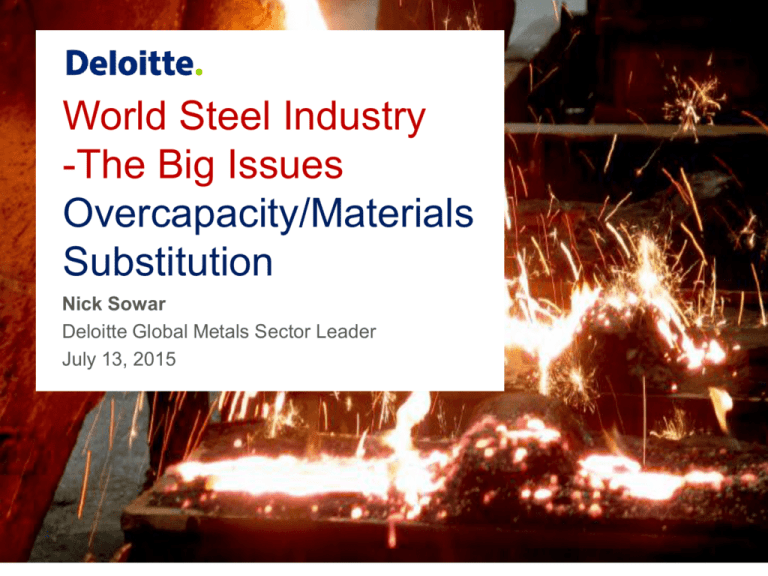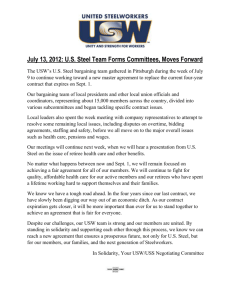
World Steel Industry
-The Big Issues
Overcapacity/Materials
Substitution
Nick Sowar
Deloitte Global Metals Sector Leader
July 13, 2015
Overcapacity---How did we get
here?
2014 World crude steel production by country
Ukraine; 1,6%
Brazil; 2,0%
EU-28; 10,2%
USA; 5,3%
Japan; 6,7%
Russia; 4,3%
India; 5,0%
RoW; 11,1%
South
Korea;
4,3%
China,
48.5%
Source: World Steel Association: World crude steel output increases by 1.2% in 2014. 22 January 2015.
2
Copyright © 2015 Deloitte Development LLC. All rights reserved.
Global Steel Industry is
Fragmented
Almost 50%of the Top
50 steel producers in
2013 are SOEs
Source: World Steel Association. World Steel in Figures 2014. 28 May 2014.
3
Copyright © 2015 Deloitte Development LLC. All rights reserved.
World crude steel capacity (nominal) and
demand
4
Source: OECD, Overview of the current global excess capacity situation and associated policy challenges
Copyright © 2015 Deloitte Development LLC. All rights reserved.
Steel capacity utilization ratio during the last 30
months
5
Source: World Steel Association press release January 2015
Copyright © 2015 Deloitte Development LLC. All rights reserved.
Chinese steel industry facing an overcapacity
challenge…
Though China experienced a continuous rise in steel
production, consumption has failed to match the production,
leading to over-capacity across the industry.
China crude steel production v/s consumption
1000
30%
25%
Million tonnes
800
20%
600
15%
400
10%
200
5%
0
0%
Crude Steel Production (LHS)
Consumption (LHS)
YoY Production Growth (RHS)
YoY Consumption Growth (RHS)
Source: Baoshan Iron & Steel, Morgan Stanley Research, 01 April 2013, World steel in figures 2013, World Steel Association
6
Copyright © 2015 Deloitte Development LLC. All rights reserved.
What has happened globally to the steel industry
Steel mills profitability under pressure, particularly distressed
China. Downstream and distribution profitability insufficient in
EU, much better in USA.
7
Source: Marcegaglia, Antonio; Marcegaglia; presentation to Steel Success Seminar June 8-10, 2015
Copyright © 2015 Deloitte Development LLC. All rights reserved.
How did Overcapacity of Steel Production Occur
in China?
Ease of finance:
• Availability of cheap credit for Chinese steelmakers.
• Chinese banks can alter payment terms even if the
steelmaker under goes serious financial strain because
such banks enjoy implicit backing from the State.
Source: ‘Surging Steel Imports Put Up To Half a Million U.S. Jobs at Risk’, Economic Policy Institute, 13 March, 2014, ‘China’s Steel Industry and Its Impact on the United
States: Issues for Congress’, CRS Report for Congress 2010, Financial Times
8
Copyright © 2015 Deloitte Development LLC. All rights reserved.
Chinese exports of steel increase as the price
per ton decreases
Source: Bloomberg
9
Copyright © 2015 Deloitte Development LLC. All rights reserved.
Overcapacity– Challenges to
correcting the steel capacity
imbalance
Quotes from “The Chinese Steel Industry’s
Transformation”
• “The dynamic change in China’s comparative
advantage in producing and exporting capital-intensive
goods has made the production of these outputs such
as steel products more competitive on international
markets through taking advantage of relatively low
costs.”
• “Since the accession (to the World Trade Organization,
2001), the (Chinese) government has removed all of the
direct subsidies to its (steel) enterprises.”
© 2014. For information, contact Deloitte Touche Tohmatsu Limited.
11
Global top 5 net exporters of steel
Source: Worldsteel association, World Steel In Figures 2014; Reuters.com. Big China steel thrives, stoking export fears, 27
April 2015; ISSB.co.uk, Global Crude Steel Production
12
Copyright © 2015 Deloitte Development LLC. All rights reserved.
Iron Ore statistics for the global top steel
net exporters
Source: Worldsteel association, World Steel In Figures 2014; ISSB.co.uk, Global Crude Steel Production; Deloitte, 2013 Global Manufacturing
Competitiveness Index; IEA.org, Russian Electricity Reform 2013 Update, April 2013; Interfax.com.ua, Wholesale market price of electricity in
Ukraine increases by 13.7% in 2014, February 2015
13
Copyright © 2015 Deloitte Development LLC. All rights reserved.
Electricity cost for industry for the global top 5
steel net exporters
20
17,9
18
US cents/ kWh
16
14
12
10
8
8,2
7,4
7,3
7,0
6
4
2
0
China
Japan
Ukraine
Russia
South Korea
Note: 3Ukraine electricity price is for year 2014, Average currency conversion rate used for year 2014: UAH1=USD0.0846 as per Oanda.com as
on 20 May 2015; 4 Approximate Electricity price for Industrial > 750 кVA customer class in Russia, Average currency conversion rate used for
year 2011: RUB1=USD00.0341 as per Oanda.com as on 20
May 2015
Source: Worldsteel association, World Steel In Figures 2014; ISSB.co.uk, Global Crude Steel Production; Deloitte, 2013 Global Manufacturing
Competitiveness Index; IEA.org, Russian Electricity Reform 2013 Update, April 2013; Interfax.com.ua, Wholesale market price of electricity in Ukraine
increases by 13.7% in 2014, February 2015
14
Copyright © 2015 Deloitte Development LLC. All rights reserved.
Subsidies offered by the Chinese government
should be deemed “Unfair Trade”
Unfair trade: includes practices such as
creating foreign trade barriers through
excessive subsidies, etc. to produce
the products and exporting them at
below cost to gain market share.
Safeguards required:
regulations to provide coverage
for producers who have
disadvantages in a free market
Key reasons why it is Chinese steel trade should be unfair:
Subsidies: Chinese government provides subsidies to its steel industry in form of cheap
land, tax rebates, support for loan payment and straight-up cash to bolster growth.
Subsidies accounted for ~80% of the profits of Chinese steel companies during first half of
2014. Government support aids Chinese steel industry export steel at lower price.
―In 2014, the United States accused China of unfairly trading its steel. The US Department
of Commerce estimated a subsidy rate of 49.15% on import of electrical steel from
Chinese exporters.
Less stringent regulations: Chinese steel industry benefits economically from less
stringent environmental requirements as compared to the U.S. and other countries.
- Chinese air and water pollution standards are less stringent
- Steel companies of China have less number of pollution control equipment
15
Source: ‘China’s Steel Industry and Its Impact on the United States: Issues for Congress’, CRS Report for Congress 2010
Copyright © 2015 Deloitte Development LLC. All rights reserved.
Some of the Chinese foreign trade barriers violate WTO
agreements, distort global trade, create an un-level playing
field to the detriment of steelmakers around the world.
Export restrictions:
Investment barriers:
•Government of China has imposed
export quotas, export taxes, and other
measures to limit the export of raw
materials (e.g., tungsten,
molybdenum), for the benefit of its
domestic industries
•The Chinese government strictly
regulates investment by foreign firms
within China.
•China imposes a 40 percent duty on
exports of steel scrap, and a 10
percent duty on exports of coking
coal.
Subsidies:
China’s
foreign
trade
barriers
- per AISI
•Chinese government provides subsidies
through preferential loans and directed
credit, equity infusions, debt-to-equity
swaps, government-mandated mergers,
tax exemptions and rebates, and direct
cash grants.
Import barriers:
• China’s Steel and Iron Industry
Development Policy, issued in July
2005, discriminates against imports of
foreign steel and foreign-produced
equipment, contrary to China’s WTO
commitments.
16
State-owned enterprises and
government intervention:
•China has created massive state owned
and -controlled national champions that
are designed to be competitive on the
international stage.
Source: American Iron and Steel Institute, AISI comments to USTR on NTE report, 29 October 2014
Copyright © 2015 Deloitte Development LLC. All rights reserved.
Material Substitutions
Sources of Improvements in Light Vehicle GHG
Emissions
Weight savings will directly contribute 12% of the GHG
reductions required by 2025, and weight savings will indirectly
contribute significantly to the growth of smaller engines
18
Source: Shultz, Richard; Ducker Worldwide; presentation to Steel Success Seminar June 8-10, 2015
Copyright © 2015 Deloitte Development LLC. All rights reserved.
Steel’s advantage over aluminum markets
Strength; 20%
Cost; 52%
Sustainability;
14%
Durability; 4,5%
Environmentally friendly
production; 4,5%
Infographics from AMM Steel Success Seminar , June 16-18, 2014
Manufacturing and
maintenance; 4,5%
© 2014. For information, contact Deloitte Touche Tohmatsu Limited.
19
19
Copyright © 2015 Deloitte Development LLC. All rights reserved.
Cost of ownership also favors steel
• In addition to the cost advantage steel affords carmakers…
• Purchasers of aluminum-using vehicles will spend more for insurance and repair
Part costs
Part
Steel
Aluminum
Fender
$208
$510
Door
$510
$1036
Pittsburgh Tribune Review Estimates: March 23, 2014
Kavanagh, Lawrence, Steel Market Development Institute, Presentation to the AMM Steel Success Seminar , June 16-18, 2014
© 2014. For information, contact Deloitte Touche Tohmatsu Limited.
20
20
Copyright © 2015 Deloitte Development LLC. All rights reserved.
Ricardo’s Six Components of Vehicle Mass
Vehicle Mass Breakdown
Source: Final Regulatory Impact Analysis, CAFE for MY2017 - MY2025, NHTSA
21
Source: Marcus, Peter; World Steel Dynamics; presentation to Steel Success Seminar June 8-10, 2015
Copyright © 2015 Deloitte Development LLC. All rights reserved.
Dramatic Reduction in Engine Size
22
Source: Marcus, Peter; World Steel Dynamics; presentation to Steel Success Seminar June 8-10, 2015
Copyright © 2015 Deloitte Development LLC. All rights reserved.
Dramatic Reduction in Engine Size (continued)
Mass Reduction Summary: Light Truck
*Note: Scenario assumes 10% weight reduction can be achieved by MY2025
23
Source: Marcus, Peter; World Steel Dynamics; presentation to Steel Success Seminar June 8-10, 2015
Copyright © 2015 Deloitte Development LLC. All rights reserved.
Aluminum 6111 vs BH 340
24
Source: Marcus, Peter; World Steel Dynamics; presentation to Steel Success Seminar June 8-10, 2015
Copyright © 2015 Deloitte Development LLC. All rights reserved.
Overcapacity in the auto aluminum sheet supply
would be bad for steel
Once all this new sheet capacity is in place, the aluminum
companies may have to lower the prices for auto sheet in
order to keep these plants running at or near capacity
25
Source: Shultz, Richard; Ducker Worldwide; presentation to Steel Success Seminar June 8-10, 2015
Copyright © 2015 Deloitte Development LLC. All rights reserved.
Ducker’s Long Term Prediction
Nearly 50% of light vehicle hoods are already aluminum, but
most other body and closure parts will remain more than 50%
steel well into the future. Steel will lose some battles, but
because of it’s lower installed cost; steel will remain
dominant for many years to come
26
Source: Shultz, Richard; Ducker Worldwide; presentation to Steel Success Seminar June 8-10, 2015
Copyright © 2015 Deloitte Development LLC. All rights reserved.
About Deloitte
Deloitte refers to one or more of Deloitte Touche Tohmatsu Limited, a UK private company limited by guarantee, and its network of
member firms, each of which is a legally separate and independent entity. Please see www.deloitte.com/about for a detailed
description of the legal structure of Deloitte Touche Tohmatsu Limited and its member firms. Please see www.deloitte.com/us/about
for a detailed description of the legal structure of Deloitte LLP and its subsidiaries. Certain services may not be availableto attest
clients under the rules and regulations of public accounting.
Copyright © 2013 Deloitte Development LLC. All rights reserved.
36 USC 220506
Member of Deloitte Touche Tohmatsu Limited






